If you’re looking for a grand meal to have for a special occasion, why not make a standing rib roast? The biggest draw back to making this meal is the cost of the beef, but if you’re willing to splurge (it is a special occasion, after all), this is a recipe that really cooks itself. It just requires time.
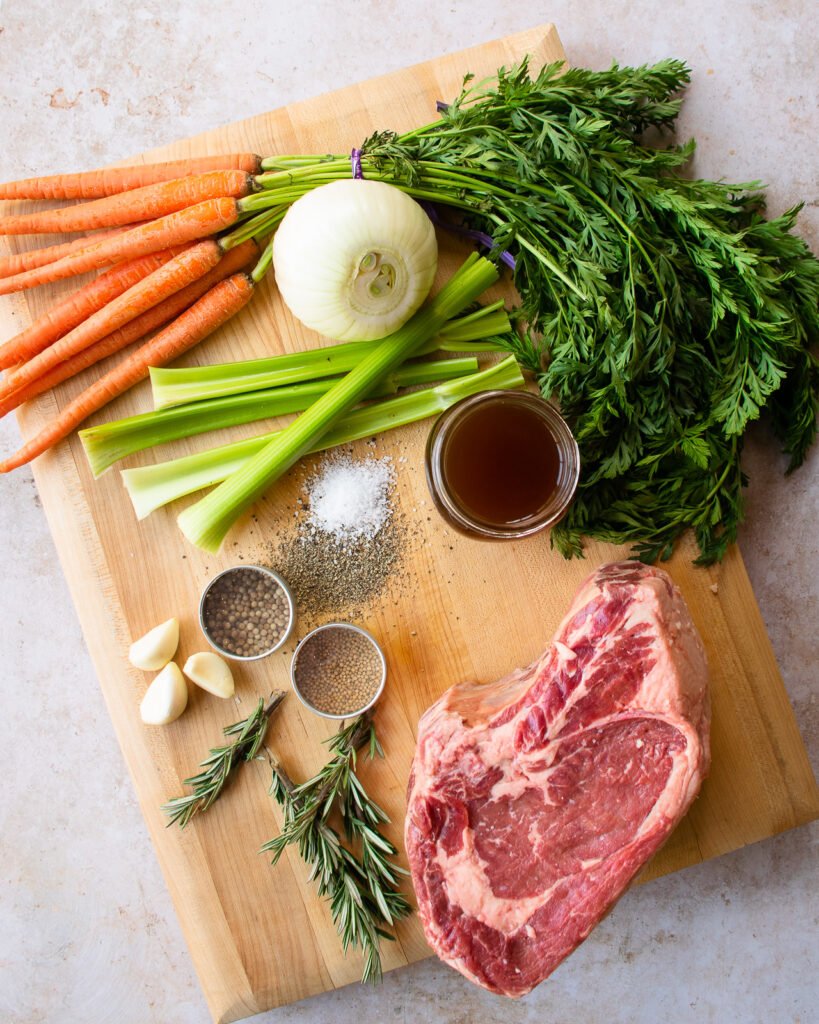
Buying the right meat is the first step in preparing a standing rib roast. A side of beef has 13 ribs. The first five come from the shoulder (or chuck) of beef, the next seven are from the rib section and the last is part of the loin. It’s the rib section (ribs 6 to 12) that is known as prime rib and that’s what we’re looking for in this recipe. Now, you won’t need all seven ribs unless you are feeding a huge crowd (and mortgaging your home) and generally butchers divide prime rib into two cuts – the first cut and the second cut. The first cut is closer to the loin end and it tends to be more tender. The second cut is closer to the chuck end and has a little more fat, making it a little more flavorful. Either cut is delicious. (the prime rib in the photo above is the second cut). Generally, plan for one pound of roast per person. A two-rib roast should feed 6 to 8 people.
Beef is always graded and you can also choose your roast with this in mind. Prime is the top-quality grade and refers to the amount of fat marbling in the roast – more marbling of fat means it is more tender and more tasty. Choice is a level down and beef with this grade has less marbling. You’ll find prime grading increases the price tag significantly, but if it’s a special occasion, it might be worth it to you. If you’re celebrating on a budget, go for choice grade and know that any prime rib is a great cut of beef.
Finally, there’s one more thing to check when you buy your roast. It’s important to make sure that the chine bone has been removed or at least cracked. The chine bone is the backbone that runs down holding all the ribs together. In order for you to be able to more easily slice the roast, the chine bone needs to be removed or cracked so that you can slice your knife between the ribs.
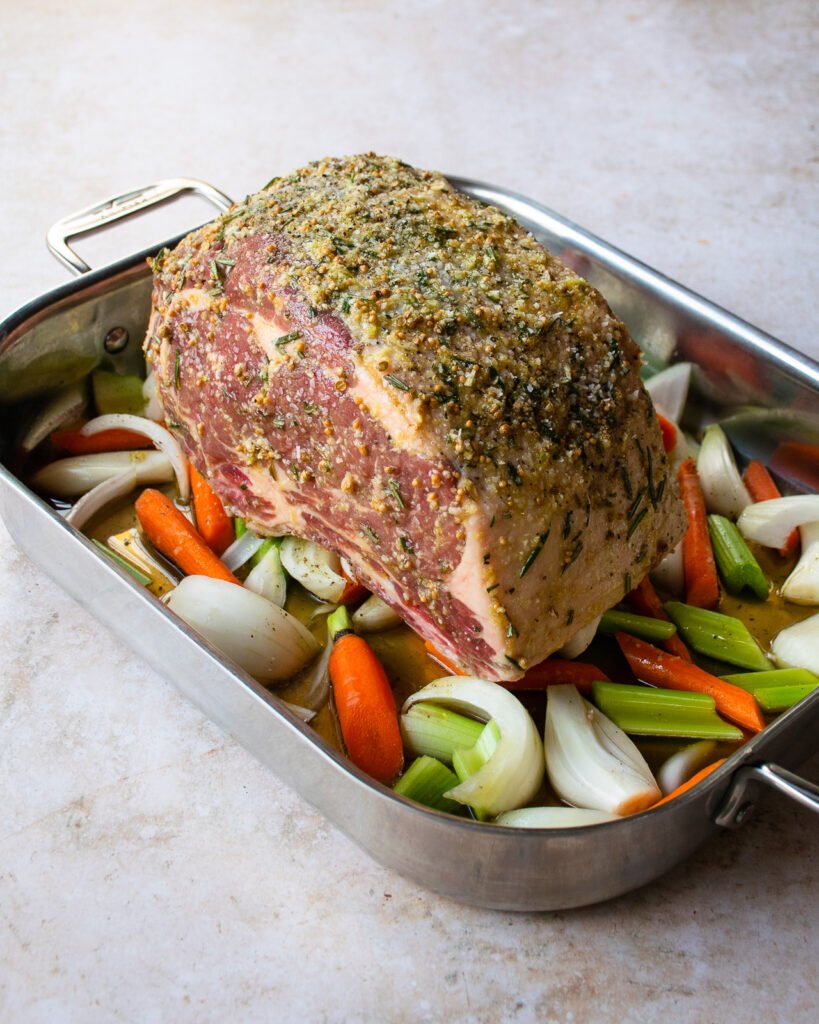
Once you have your raw prime rib roast at home, make sure you leave it out on the counter for at least an hour (or even up to three hours) to take the refrigerator chill off the meat. Doing so will allow the roast to cook more evenly. Because most of the meat in a roast does not come into contact with the seasoning, I like to make a super flavorful rub to put on the outside of the roast that will form a crust as the beef roasts. When the roast is sliced, it will be the little piece of this crust that will give a burst of flavor to the meat. Purée the spices and herbs in a mini food processor and rub this on the roast, season really generously with salt and freshly ground black pepper and let it sit at room temperature while you do other things, including pre-heating the oven.
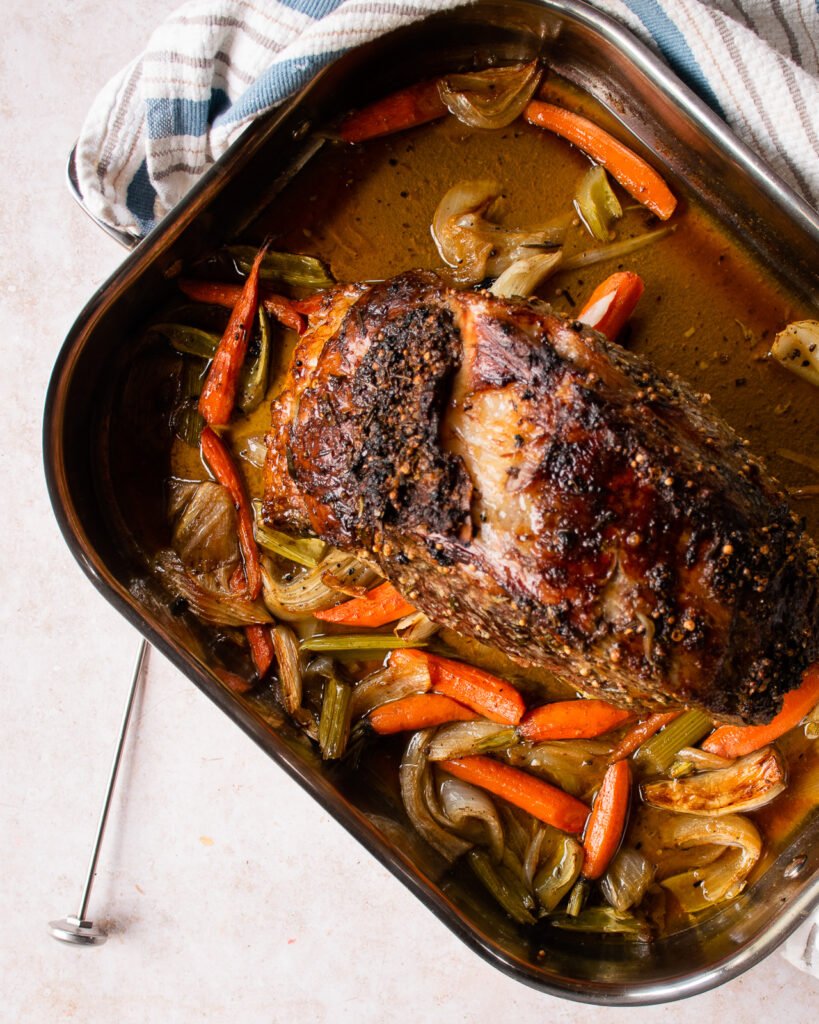
Elevating the roast from the bottom of the roasting pan is important, but you don’t have to use a rack to do so. With a standing rib roast, you place the roast rib-side down and the ribs will actually work as a rack. You can also use vegetables (as in this recipe) and rest the beef on those cut vegetables to get it off the bottom of the roasting pan. Of course, the big bonus here is that the vegetables will roast in the beef drippings and be a delicious accompaniment to the finished beef. They will also contribute to the flavor of the drippings, so that you have a more flavorful jus to serve at the end. Win-win-win.
I like to start the roast at a high temperature (425ºF) to sear the outside of the roast. This gives the roast a good jump start on browning and begins to create that flavorful crust on the top. After 25 minutes of searing, the cooking time will depend on a number of factors – the shape of the roast (how tall and thick the roast is versus flat), the temperature of the roast when it goes into the oven and even your oven itself. For a medium-rare roast, roughly 16 minutes per pound (total) is about right, but the only way to know for sure is to use an instant-read thermometer inserted into the very center of the roast to gauge the doneness. A medium-rare roast should be at about 125ºF. For a roast cooked to a rare doneness, roast for 13 minutes per pound (total) and make sure the roast reaches an internal temperature of 120ºF. For medium, roast for about 20 minutes per pound (total) and look for an internal temperature of 130ºF.
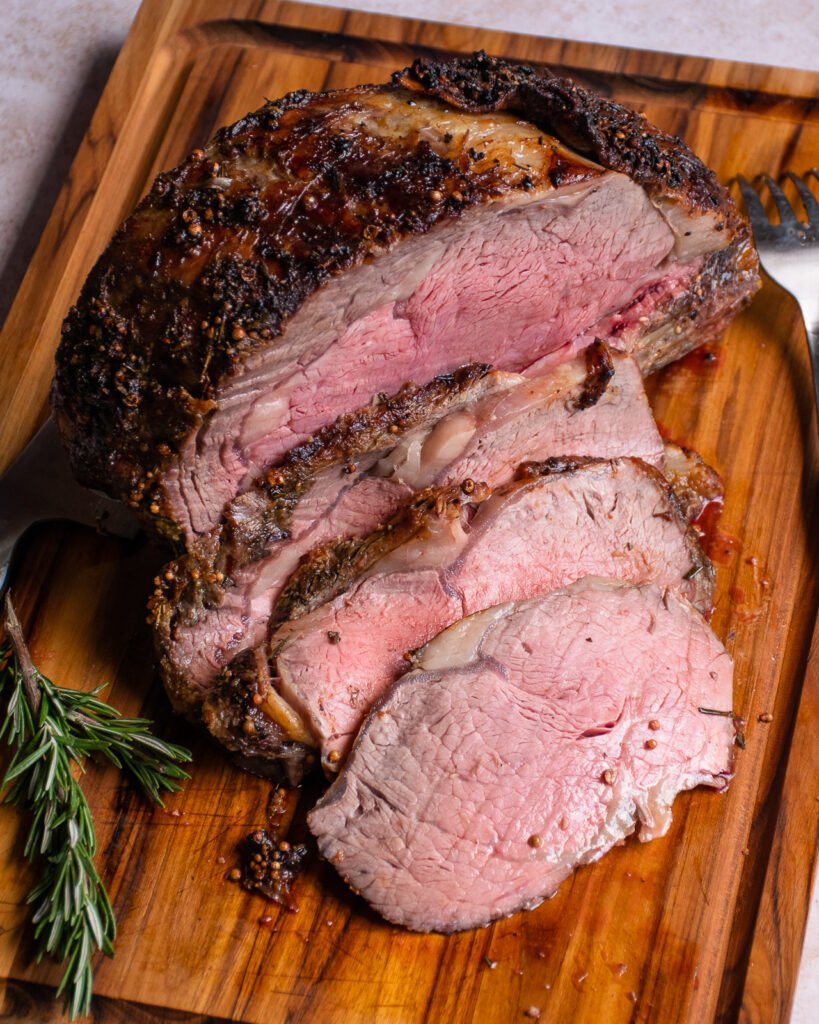
I can’t stress enough how important it is to also let the roast rest after it has finished roasting. This lets the juices in the roast redistribute themselves and allows the muscle fibers in the roast to relax. Cutting into the roast as soon as it comes out of the oven will just result in those juices pouring out of the roast onto your cutting board. Letting the roast relax will allow more of those juices to stay in the roast. So, plan for at least 20 to 25 minutes of resting time. While you wait, you can broil the vegetables, strain the juices into a fat separator for a jus or make a gravy.
When it comes to slicing the roast, my advice is to cut the rib bones off first. (You can actually cut the rib bones off before roasting and tie them back onto the roast with kitchen twine to roast the beef. That way, the bones will just come away from the meat easily before slicing.) With the bones cut off the roast, you can then slice the roast into thin or thick slices – whichever you like.
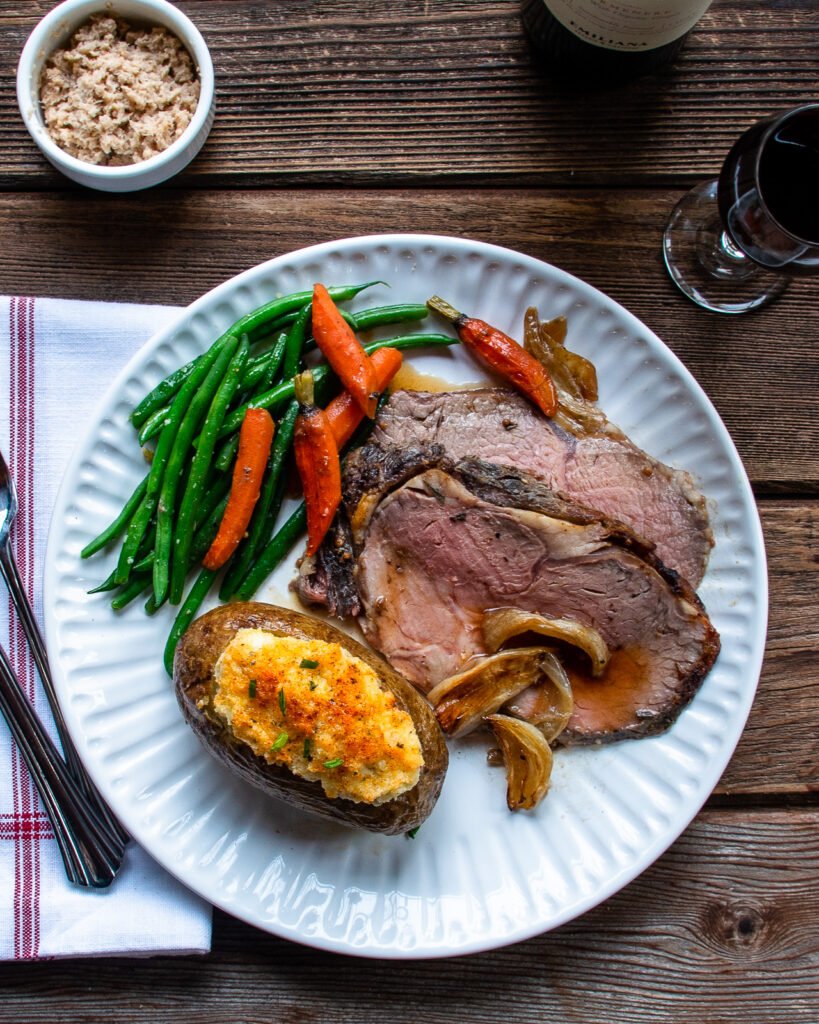
A beautiful plate of prime rib roast beef can be dressed with any number of delicious vegetable dishes. In addition to, or instead of the vegetables that roasted with the beef, try some Brussels sprouts or green beans or make it a traditional meat and potatoes dinner with mashed potatoes, roast potatoes or a baked potato as above. Pour the jus over the top, or put gravy on the table (in a sauce boat ideally!), lift a glass and enjoy your special occasion.
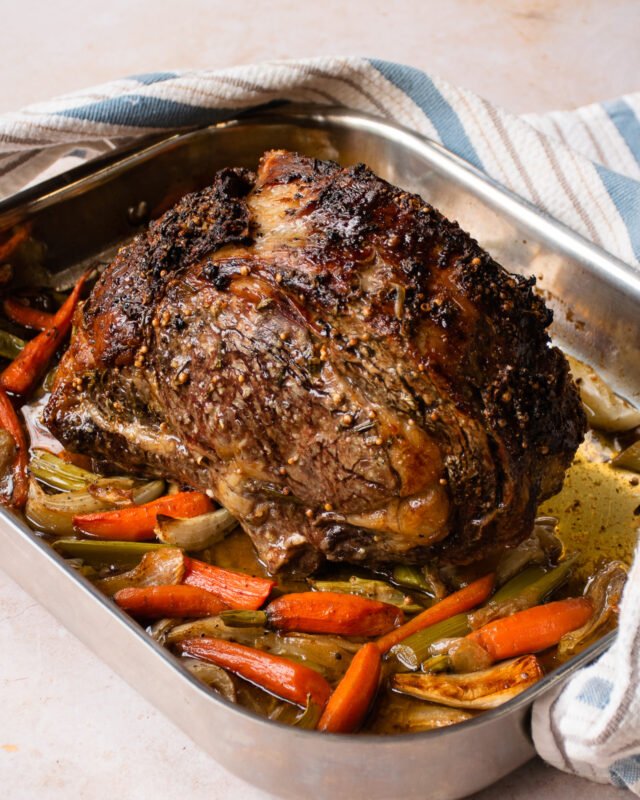

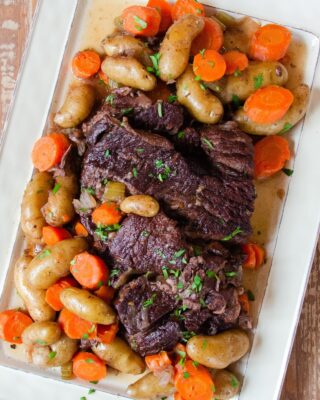
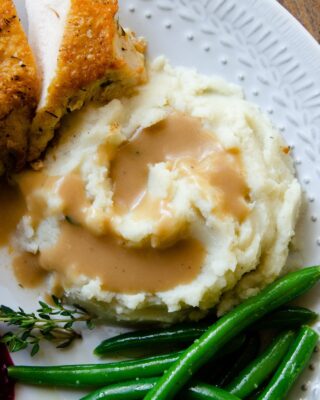
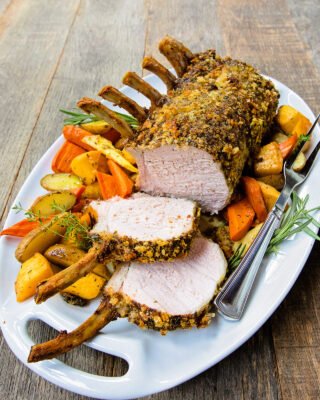
I’ve been making many of your pressure cooker recipes and they’ve come out great. I’ll try this for Xmas eve. Happy holidays!
Going to use the Standing Rib Roast recipe for Christmas. I have never tried the type os seasonings you suggest. Something new and different. Thank you. Miss you on the Q,
I am making this recipe for Christmas Day.Thank you for the inspiration. I love following you and trust your recipes and timing. You have not changed at all after all these years. Thanks
Thanks, Kathy! 😊
Do you have a tried and true popover recipe to serve with the standing rib roast?
Hi Kathy. I’m afraid I don’t have a tried and true popover recipe written down right now, which is a crime really given my British mother! I’ll work on that!
We have a small 3.7 # roast…..do we still roast for the additional 16 minutes per #? We love your recipes.
Yes, that’s right. Your total cooking time should be around an hour (16 minutes x 3.7 pounds =59.2 minutes), so subtract the initial 25 minutes at 425ºF. You should leave the roast in the oven for another 35 minutes. That way, your total cooking time will be an hour.
Thanks…….Happy Holidays !!!!!!
Followed the instructions exactly using a small (2.5 lb) roast for two, today, for Christmas dinner. Roasted at 450 F for 25 min then turned the oven down to 350F until instant read thermometer hit 125 F. Let it rest 30 min while baking the twice baked the second time. It came out a perfect medium rare. Highly recommend this recipe. Used the vegetable bed as an addition to a beef barley soup being made with the leftover rib meat.
I modified the seasonings a little and only used potatoes and onions for the base, but the roast came out perfectly m rare and I almost couldn’t stop eating the potatoes and onions. I give this one 10 thumbs up! (salt, pepper, thyme, basil, rosemary, olive oil and garlic buzzed to a paste. Cut off the fat cap and after seasoning the top, skewered the fat cap back on.)
We have used this recipe for any years. This year we cooked a 20 pound prime rib, preseasoned and tied from our favorite butcher. It comes out a perfect medium-rare every time. We combine it with French onion soup, caramelized onion risotto, roasted asparagus and New York cheese cake.
Thank you so much! Love this recipe and so do our guests!
Perfect Easter dinner. Clear instructions and paired with your PopOvers … it was a hit. Thank you.
What are your thoughts on reverse searing?
Hi Paula. I am a firm believer in the notion that there are several ways to a perfect end. Reverse searing can be really effective, especially for a large rib roast where getting an even degree of doneness throughout the roast can be a real challenge. While this recipe uses the more traditional method of roasting a large joint of beef, you could change the directions to roasting the beef at a low 300˚F until the internal temperature is around 125˚F for medium rare (or higher if you want it cooked more), let the roast rest for 20 minutes (or longer, covered in foil) while you crank the oven up to 500˚F and then return the roast to the oven for 10 minutes or so to get that dark crust on the outside (or you could sear it on the stovetop if you prefer). That would give you a beautiful result as well.